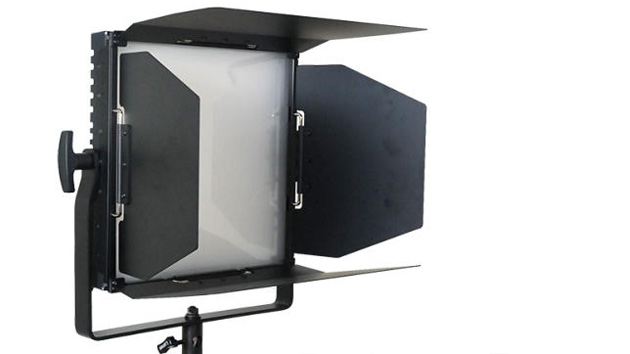Progress in Leaps and Lumens
Offering much higher output, improved colorimetry, and smoother beam spread, the latest LED lighting has truly come of age. Indeed, it's not uncommon in new studios these days to see only LED fixtures on floor stands and in the overhead grid. The LED light quality and character are just that good; the newest LED instruments continue to improve in leaps and lumens.
The Lumos 300MK is a reflection of the newest super-LED trend. Utilizing the latest IC technology, the Lumos 300MK is fundamentally a studio fixture with an output that is among the smoothest and most color-accurate I've seen in 1X1 multi-array fixtures. The LED grid itself contains 288 individual IC LED lamps, which produce a lovely flattering coverage that I found especially effective on dark skin.
The Lumos 300MK output is very smooth and color-accurate, featuring the highest CRI (98) available in a professional LED instrument.
The Lumos CRI
[footnote] of 98 (under tungsten conditions) is well above average — the highest I’ve seen in a currently available commercial fixture. Working with the 300MK, I saw no hint of the dreaded green curse typical of many LED units. This level of accuracy makes the Lumos suitable for the most critical chromakey applications.
The Lumos build quality is better than average, with beefy controls and a rugged barndoor included standard.
The use of brighter, higher-output IC LEDs allows the integration of a diffusion panel, which helps eliminate or at least reduce the menace of multiple shadows that are not unusual in 1×1-type lighting. Incidentally the unit supports a rugged four-way barndoor, which is included standard, thank you very much.
The illluminated indicators feature a red/green color scheme that is illogical and confusing.
For all its strong points, the Lumos 300MK has a few annoying shortcomings. The LED indicators on back for color and dimmer level are well incremented and allow for easier visibility in the overhead grid of a dark set. Unfortunately the indicators’ red/green color scheme is illogical. How is green associated with a tungsten or warmer source? How is red associated with daylight? How does red or green connote beam intensity? Clearly these parts were repurposed from a battery charger or similar device where red/green makes sense to reflect charge status.
The 300MK battery requires a pigtail that is prone to getting lost or misplaced. The fragile consumer plug on one end has no place on a professional lighting instrument.
The optional Li-Ion battery (+$420) is well integrated, mounts securely in back, and features a nifty power level LED (with the correct color nomenclature). Unfortunately the design employs a supplemental power connector pigtail that is prone to getting lost, which would render the light unusable from DC power. The six-inch pigtail is also incongruously fitted with a flimsy consumer-grade charger connector that can and has caused trouble in less professional devices.
The Lumos uses a 3-pin XLR for power that most professionals associate strictly with audio applications.
Just as maddening, perhaps, is the 3-pin XLR power plug — a configuration that most professionals associate with a microphone and other audio applications. From years of conditioning I, for one, experience heart palpitations when plugging power into a 3-pin XLR jack, when a 4-pin XLR is expected and has been used for decades for DC power.
Despite those shortcomings, the Lumos 300MK is a solid, high-performance instrument — perhaps the best performer on the market today. Given its design and DMX controller, the Lumos is a bit too bulky for run-and-gun ENG work. For this, the Litepanels 1 X 1 fitted with a Gold Mount and Anton Bauer battery is more practical and travel-friendly.







Leave a Reply